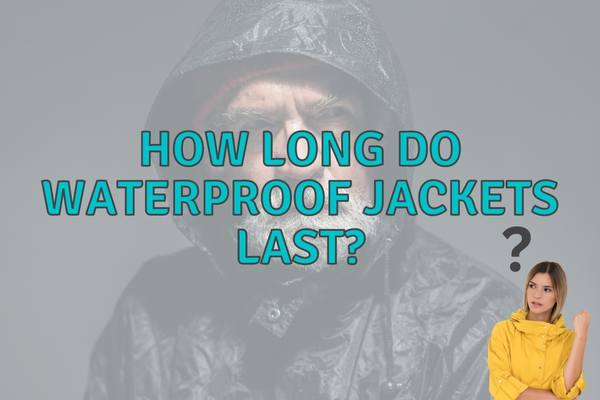We all know that waterproof jackets are essential for staying dry in the elements but not everyone knows just how long they can be expected to stay effective?
A good waterproof jacket made from rubber or PU coated polyester can last for decades, whereas modern shell jackets will slowly loose breathability and water resistance (especially around the seams and shoulders).
A waterproof jacket using a gore-tex shell or similar membrane technology usually lasts from 3 to 5 years an a few years longer with proper care, which I will get into in this post.
From traditional nylon and polyester designs to membrane-based GoreTex fabrics, we’ll explore the factors that determine how long your jacket will last as well as some tips on caring for them so you get more mileage out of each purchase.
Contents
How long do rain jackets last?
When it comes to waterproof jackets, the question of how long they last is an important one. After all, you want your jacket to keep you dry and comfortable when out in the rain or snow.
On average, a modern waterproof shell jacket will last for 3-5 years if worn regularly. This time frame can be extended with proper maintenance such as re-proofing after heavy use or exposure to harsh weather conditions.
If taken good care of and not worn every day, a good rain jacket can last up to 10 years before needing replacement.
So obviously the answer depends on a variety of factors, including how often you wear it, what conditions you expose it to, and how well you take care of it.
The materials used in the construction of your waterproof jacket also play an important role in its longevity.
Jackets made from synthetic fabrics are generally more waterproof than those made from natural fibers like cotton or wool because they resist water better and don’t absorb moisture as easily.
Synthetic fabrics also tend to be lighter weight which makes them easier to pack away when not needed.
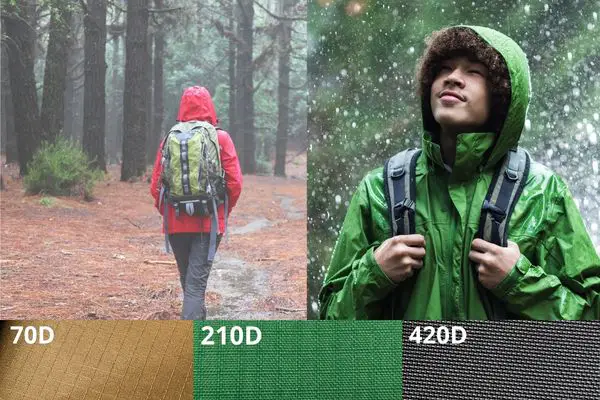
However, synthetic fabrics are often thinner than natural fabrics and somewhat more prone to wear and tear.
Nylon and polyester fabrics come in thicknesses from 10D to 420D when used in outdoor gear. The thicker the fabric, the more waterproof the fabric tends to be.
Polyester rain jackets are somewhat more waterproof than nylon jackets and also more durable but slightly heavier and less breathable.
It’s also worth considering the impermeability level that each type of fabric offers when selecting your rain gear; some materials offer higher levels of protection against water than others do so make sure that whatever material you choose meets your needs for keeping dry during wet weather activities like hiking or camping trips.
Traditional rubber or PU (polyurethane) rain jackets tend to last longer than modern GoreTex or other membrane technologies like HyVent.
This is because these more advanced materials require more maintenance and care in order to keep their breathability and waterproofing properties intact over time.
For example, if you own a shell jacket with a GoreTex membrane, it needs regular washing and reproofing with specific products designed for that purpose in order to maintain its performance level over time.
Without proper maintenance, the material will eventually lose its ability to repel water effectively, leaving you exposed during wet weather conditions.
On the other hand, traditional rubber or PU rain jackets can often be wiped clean with just soap and water without needing additional treatment – making them easier to look after in the long run!
Another factor that affects how long your rain jacket lasts is frequency of use; if you wear your jacket regularly then it won’t last as long as one that only gets used occasionally.

This is especially true for GoreTex-style shells which need frequent cleaning and reproofing due to their delicate nature – so make sure you give yours some TLC every now and again!
In general, traditional rubber or PU rain jackets tend to have a much longer lifespan than those made from newer materials such as GoreTex; so if longevity is important, then they may be worth considering when shopping around for a new coat.
Rain jackets can last for years if they are taken care of properly, but it is important to be aware of the wear and tear that comes with extended use.
Key Takeaway: Rain jackets come in a variety of materials, with traditional rubber or PU rain jackets lasting longer than more advanced membrane technologies such as GoreTex. Proper maintenance and care are key to preserving the waterproofing and breathability of your jacket over time, so it’s important to consider how often you plan on using it before making a purchase. With regular cleaning and reproofing for modern shells, plus easy-care options for traditional styles, there’s something for everyone when it comes to finding the perfect rain jacket!
Membrane Based Rain Jackets
Membrane based rain jackets are a popular choice for hikers and outdoor enthusiasts due to their lightweight, breathable construction.
These jackets feature a waterproof membrane that is laminated between two layers of fabric, creating an effective barrier against the elements. However, these types of jackets generally last for a shorter time than traditional rain jackets.

The reason why membrane based rain jackets don’t last as long as traditional ones is because they get clogged easily with dirt and debris from the environment. This clogging reduces the jacket’s breathability and water resistance over time, making it less effective at keeping you dry in wet weather conditions.
To keep your membrane-based jacket performing optimally, it needs regular maintenance such as washing and tumble drying to open up its pores again so that it can breathe properly.
Additionally, you should also reapply DWR (durable water repellent) surface waterproofing treatment every few months or after any heavy use to ensure that your jacket continues to repel water effectively.
Another factor which affects the longevity of your membrane-based rain jacket is how often you wear it. If you are using it frequently, then its lifespan may be reduced due to general wear and tear from activities such as hiking or camping trips in rough terrain or extreme weather conditions.
It is important to remember that even though these types of jackets are designed for durability, they still need proper care if you want them to remain waterproof over time.
Membrane based rain jackets are a great option for outdoor enthusiasts looking to stay dry and comfortable in any weather conditions.
How long do gore tex jackets last?
GoreTex jackets are a popular choice for hikers and outdoor enthusiasts who need reliable waterproof protection.
With proper care and moderate use, a good GoreTex shell can last for 3 to 6 years. It does however depend on the type of GoreTex shell you choose.
The most durable shells will be made with three-layer construction which is more expensive but also more resilient against wear and tear over time.

The two-layer construction is less expensive but not as resistant to abrasion or tears from branches or other sharp objects that may come in contact with your jacket while out hiking.
It’s important to note that all GoreTex shells require regular maintenance such as washing and drying after each use in order to keep their breathability intact.
This means they must be washed according to the manufacturer’s instructions using only special detergents designed specifically for waterproof fabrics like those found in Gore Tex jackets.
If this isn’t done, it can lead to decreased performance of the fabric over time, resulting in reduced water resistance levels which can affect how long your jacket lasts overall.
There are many Gore-Tex membrane technologies!
It is difficult to accurately rank the exact durability of the different Gore-Tex technologies because the durability of a fabric depends on a variety of factors, including the type of garment it is used in, the way it is cared for, and the conditions it is used in.
That being said, here is a general overview of the relative durability of the different Gore-Tex technologies (asumming all else is the same):
- Gore-Tex Pro: This fabric is known for its high durability and is often used in high-performance outdoor gear that is subjected to extreme conditions. It is made with a tough, abrasion-resistant outer layer and is treated with a durable water repellent (DWR) finish to help protect against water and dirt.
- Gore-Tex Paclite: This fabric is designed to be lightweight and packable, and is generally not as durable as other Gore-Tex technologies. It is made with a thinner, less abrasion-resistant outer layer and may not hold up as well to rough or abrasive surfaces. However, it can still be quite durable if it is cared for properly and not subjected to excessive wear and tear.
- Gore-Tex Active: This fabric is designed for use in active outdoor gear, and is generally quite durable. It is made with a tough, abrasion-resistant outer layer and is treated with a DWR finish to help protect against water and dirt.
- Gore-Tex Soft Shell: This fabric is designed for flexibility and mobility, and is generally not as durable as other Gore-Tex technologies. It is made with a stretchy, soft outer layer that is not as resistant to abrasion as other Gore-Tex fabrics. However, it can still be quite durable if it is cared for properly and not subjected to excessive wear and tear.
- Gore-Tex Insulated: This fabric is made with a waterproof and breathable membrane, and is filled with synthetic insulation to provide warmth in cold weather. It is generally quite durable, but the durability of the insulation may vary depending on the type and quality of the insulation used.
- Gore-Tex Transcendent: This fabric is made with a waterproof and breathable membrane, and is used in jackets filled with high-quality down insulation to provide warmth in extreme cold weather conditions. It is generally quite durable, but the durability of the insulation may vary depending on the type and quality of the down used.
It is important to note that the durability of any fabric can be affected by the way it is cared for, so it is always a good idea to follow the manufacturer’s care instructions to ensure that your gear lasts as long as possible.
Make sure the jacket is the right fit!
Another factor that affects how long a Gore Tex jacket will last is its fit; if it fits too tightly it won’t allow enough air circulation which could cause overheating during strenuous activities like hiking uphill or running along trails, leading to premature wear and tear of the fabric itself due to excessive friction between body parts and fabric fibers rubbing together when moving around inside the garment.
On the other hand, if your jacket fits too loosely then there’s an increased risk of moisture getting trapped inside causing condensation buildup which again leads to premature deterioration of the material due its inability to breathe properly under these conditions.
Finally, it should be noted that membrane based rain jackets generally have shorter lifespans than traditional rain jackets made from nylon or polyester.

This is because they are more prone to damage caused by UV rays from sunlight exposure over extended periods of time. Therefore, it is important to store them away safely when not being used outdoors in order to prolong their lifespan.
Gore Tex jackets are made with durable materials that can last for years if cared for properly. With the right maintenance, you can make sure your jacket stays in great condition and keeps you protected from the elements. Next, we’ll look at how to care for a Gore Tex jacket to ensure it lasts as long as possible.
Key Takeaway: A key takeaway from the above is that proper care and maintenance are essential to extend the lifespan of a GoreTex jacket. This includes washing according to manufacturer instructions with special detergents, ensuring an appropriate fit (not too tight or loose), and storing away safely when not in use. Taking these steps can help ensure your jacket will last for 3-6 years.
How long do arcteryx jackets last?
Arcteryx is a high-end outdoor apparel company that specializes in producing waterproof jackets and other outerwear. Their products are renowned for their quality, durability, and performance in the outdoors. But how long do Arcteryx jackets last?
The answer to this question depends on several factors such as the type of jacket you have purchased, how often it’s used, and how well it’s cared for. Generally speaking, an Arcteryx GoreTex shell can last anywhere from 5 to 10 years with proper care and moderate use.
This number may be lower or higher depending on the type of GoreTex shell used by Arcteryx. For example, some shells are designed specifically for extreme weather conditions while others are more suited for everyday wear.
Here are ten jackets from Arc’teryx and some thougts on how well they will last:
- Arc’teryx Beta AR Jacket: This jacket uses Gore-Tex Pro, which is a durable, waterproof and breathable fabric that is designed for use in extreme weather conditions. This jacket is expected to last for a long time with moderate use, as the Gore-Tex Pro fabric is known for its durability.
- Arc’teryx Alpha SL Jacket: This jacket uses Gore-Tex Paclite, which is a lightweight and packable fabric that is designed for use in lightweight and compact outdoor gear. This jacket is expected to last for a moderate amount of time with moderate use, as the Gore-Tex Paclite fabric is not as durable as some of the other Gore-Tex technologies.
- Arc’teryx Cerium LT Jacket: This jacket uses Gore-Tex Down Composite Mapping, which is a fabric that is designed for use in insulated outdoor gear. It is made with a waterproof and breathable membrane, and is filled with a combination of synthetic insulation and down to provide warmth in cold weather. This jacket is expected to last for a moderate amount of time with moderate use, as the Gore-Tex Down Composite Mapping fabric is generally quite durable.
- Arc’teryx Proton LT Jacket: This jacket uses Gore-Tex Active, which is a highly breathable fabric that is designed for use in active outdoor gear. This jacket is expected to last for a moderate amount of time with moderate use, as the Gore-Tex Active fabric is generally quite durable.
- Arc’teryx Zeta LT Jacket: This jacket uses Gore-Tex Paclite Plus, which is a lightweight and packable fabric that is designed for use in lightweight and compact outdoor gear. This jacket is expected to last for a moderate amount of time with moderate use, as the Gore-Tex Paclite Plus fabric is not as durable as some of the other Gore-Tex technologies.
- Arc’teryx Thorium AR Jacket: This jacket uses Gore-Tex Pro, which is a durable, waterproof and breathable fabric that is designed for use in extreme weather conditions. This jacket is expected to last for a long time with moderate use, as the Gore-Tex Pro fabric is known for its durability.
- Arc’teryx Atom LT Jacket: This jacket uses Gore-Tex Insulated, which is a fabric that is made with a waterproof and breathable membrane and is filled with synthetic insulation to provide warmth in cold weather. This jacket is expected to last for a moderate amount of time with moderate use, as the Gore-Tex Insulated fabric is generally quite durable.
- Arc’teryx Theta AR Jacket: This jacket uses Gore-Tex Pro, which is a durable, waterproof and breathable fabric that is designed for use in extreme weather conditions. This jacket is expected to last for a long time with moderate use, as the Gore-Tex Pro fabric is known for its durability.
- Arc’teryx Gamma MX Jacket: This jacket uses Gore-Tex Soft Shell, which is a stretchy, soft fabric that is designed for use in outdoor gear that requires a high degree of flexibility and mobility. This jacket is expected to last for a moderate amount of time with moderate use, as the Gore-Tex Soft Shell fabric is not as durable as some of the other Gore-Tex technologies.
- Arc’teryx Sentinel AR Jacket: This jacket uses Gore-Tex Pro, which is a durable, waterproof and breathable fabric that is designed for use in extreme weather conditions. This jacket is expected to last for a long time with moderate use, as the Gore-Tex Pro fabric
When caring for your Arcteryx jacket it is important to follow the manufacturer’s instructions regarding washing and maintenance procedures.
All Gore-Tex shells need regular cleaning and maintenance in order to keep their breathability intact over time; otherwise they will lose their water resistance capabilities sooner than expected.
Additionally, traditional rain jackets made out of nylon or polyester tend to last longer than membrane based rain jackets like those produced by Arcteryx due to their construction materials being more durable over time compared to membranes which degrade faster when exposed to harsh elements such as UV rays or windy environments.
If you take good care of your Arcteryx jacket, it should last for at least five years before needing to be replaced. This may be longer depending on how often you use it and the environmental conditions that it is exposed to.
When it comes to the longevity of Arcteryx jackets, there are many factors that can affect their lifespan. In the next heading, we will explore how you can extend the life of your jacket and ensure maximum protection for years to come.
Key Takeaway: A key takeaway from this article is that Arcteryx jackets can last anywhere from 5 to 10 years with proper care and moderate use. To ensure the longevity of your jacket, it is important to: – Follow manufacturer instructions for cleaning and maintenance – Avoid exposing the jacket to harsh elements such as UV rays or windy environments – Clean and maintain regularly.
Traditional Rain Jackets
Traditional rain jackets are a popular choice for hikers and outdoor enthusiasts due to their durability and water resistance. These jackets typically have an outer layer made of nylon or polyester, with either a waterproof coating or laminate that prevents water from seeping through the fabric.

The inner lining is usually made of fleece, wool, or synthetic insulation material which helps keep you warm in cold weather conditions. Traditional rain jackets can last longer than other types of jackets because they don’t require regular washing and maintenance like shell jackets do.
These traditional rain coats also offer some advantages over breathable shell-style jackets such as GoreTex and Arcteryx models.
They tend to be more durable since they don’t need to be washed regularly; this means that you won’t have to worry about losing the waterproofing on your jacket after just a few uses.
Additionally, these traditional rain coats are generally heavier than breathable shells but provide better protection against wind and precipitation due to their thicker construction materials.
On the downside, traditional rain coats aren’t as breathable as shell-style garments so if you’re planning on wearing them during strenuous activities then it’s important to take breaks often in order to avoid overheating yourself too much.
Also, while these types of garments may last longer than other styles they still need occasional cleaning in order maintain their waterproofing capabilities; dirt particles can accumulate on the surface over time which reduces its effectiveness at repelling moisture from outside sources such as rainfall or snowfall.

Overall, traditional rain coats are great options for those who want reliable protection against wet weather without having to worry about frequent washing cycles like with membrane based garments such as GoreTex or Arcteryx models.
However, it is important not to forget that even though these types of garments may last longer than others they still require periodic cleaning in order to keep up their performance levels over time; so make sure you factor this into your decision when choosing what type of jacket best suits your needs.
Traditional Rain Jackets are a great choice for hikers and outdoor enthusiasts looking to stay dry during their adventures, but it’s important to know how long they can last so you can plan accordingly. Now let’s look at the more modern alternatives that offer even better protection from the elements.
Key Takeaway: Traditional rain coats are a great choice for hikers and outdoor enthusiasts due to their durability and water resistance. They don’t need regular washing like shell jackets, offer better protection against wind and precipitation, but aren’t as breathable. To keep them in good condition, they should be cleaned periodically to maintain their waterproofing capabilities. Key takeaways: – Durability & water resistance – No regular washing needed – Better protection from wind & precipitation – Not as breathable compared to shells – Clean periodically for best performance
How long do Nylon or Polyester Rain Jackets Last?
Nylon and polyester are two of the most common materials used in rain jackets. Both fabrics offer excellent water resistance, breathability, and durability. But how long do they last?
The answer depends on a few factors, including the thickness of the fabric and its surface treatment.
Generally speaking, polyester is more durable than nylon when it comes to long-term wear, but nylon resists sudden tears and impacts better. Polyester is more resistant to sunlight and does not absorb as much water as nylon does.
If you want an in-depth comparison of nylon and polyester, check out my latest post on the topic here:
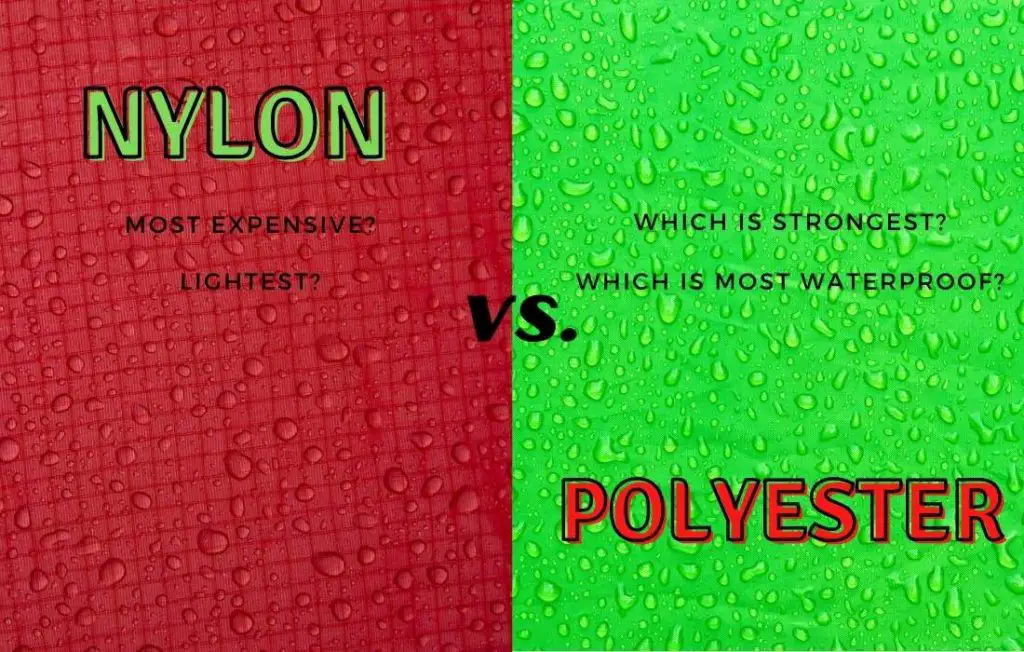
It’s also less likely to tear or rip if you snag it on something while hiking or camping. However, both fabrics can be treated with coatings that increase their water-resistance and longevity.
For example, many nylon jackets feature a Durable Water Repellent (DWR) coating which helps repel moisture from the fabric’s surface so that it doesn’t soak through as quickly as untreated material would.
This type of coating typically lasts for up to 10 washes before needing to be reapplied or replaced entirely depending on usage conditions like exposure to dirt or sweat during activities such as hiking or backpacking trips.
Polyester is often coated with silicone elastomer which creates an additional layer of protection against water penetration while still allowing some breathability so you don’t get too hot inside your jacket during strenuous activities outdoors.
This type of coating generally lasts longer than DWR coatings but will eventually need replacing after extended use over time due to wear and tear from abrasion against rocks or other rough surfaces encountered while out in nature exploring trails and mountainsides alike!
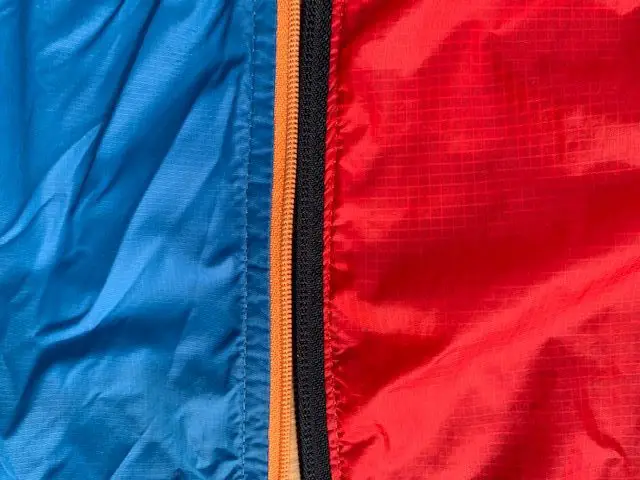
In terms of overall lifespan for these types of rain jackets made from either nylon or polyester materials, expect them to last anywhere between 3-6 years depending on how much they are worn and used regularly along with any maintenance performed such as re-waterproofing treatments applied every 6 months to 1 year intervals, or sooner.
If taken care of properly, these garments should provide ample protection from wet weather conditions throughout multiple seasons without having too much concern about them wearing out prematurely.
Rain jackets made of nylon and polyester are designed to withstand the elements for years, but regular maintenance and proper care can help extend their life. Next, let’s explore how to properly clean and store your rain jacket.
Key Takeaway: Nylon and polyester rain jackets are less durable than traditional rubber rain jackets, but can last many years if taken care of properly. To ensure maximum protection from wet weather conditions, these garments should be re-waterproofed every 6 months to 1 year intervals. Nylon is usually treated with Durable Water Repellent (DWR) coating while polyester often has a silicone elastomer coating for additional water resistance and breathability.
Do waterproof jackets lose their water resistance over time?
Waterproof jackets are an essential piece of gear for hikers and outdoor enthusiasts, providing protection from the elements in a lightweight package.

But like any other garment, they don’t last forever. Over time, waterproof jackets can lose their water resistance due to wear and tear or improper care.
Membrane Based Rain Jackets
Rain jackets made with membrane technologies such as Gore-Tex or eVent tend to have shorter lifespans than traditional rainwear. These materials require regular washing and maintenance to keep their breathability, which is necessary for them to remain waterproof over time.
If not cared for properly, these membranes will eventually become clogged with dirt and oils that reduce their effectiveness against moisture.
So even if they look intact, they do not function properly anymore!
Additionally, some brands use proprietary coatings on top of the membrane layer that may also degrade over time if not maintained correctly.
The lifespan of a Gore-Tex jacket depends largely on how often it is used and how well it is taken care of; however, most experts agree that you should expect your Gore-Tex jacket to last around three years before needing replacement if cared for properly during its lifetime.
Arc’teryx’s own website states that “the average life expectancy of our garments varies depending on usage but generally ranges between two and five years.”
As with all technical apparel items made from high performance fabrics such as Gore-Tex or eVent fabrics, proper care will help extend the life span significantly beyond this range when done regularly according to manufacturer instructions..
Traditional Rain Jackets
Traditional rainwear such as nylon or polyester does not contain any special coating or membrane technology so it tends to be more durable than modern options made from advanced materials like Gore-Tex or eVent fabrications.
However even traditional rainwear can still suffer damage over time due to UV exposure (sunlight) which causes fading/discoloration in addition to general wear & tear associated with frequent use outdoors in wet conditions.

Generally speaking though you should expect your traditional rain jacket will provide several seasons worth of reliable protection before needing replacement if treated well throughout its lifetime..
Yes, waterproof jackets can lose their water resistance over time, especially those featuring advanced membrane technologies like Gore Tex or eVent fabrications which need regular cleaning and maintenance to maintain their breathability levels needed for effective water repellency.
On the other hand, PU (polyurethane) coated rubberized nylon and polyester fabrics tend to be more durable overall compared to modern options since they lack any kind of special coating/membrane technology yet still offer a good level of weather protection at a reasonable price point making them a popular choice among budget conscious shoppers looking to get the most bang for their buck out of their purchase.
Waterproof jackets are a great investment for hikers and outdoor enthusiasts, but it is important to know that they can lose their water resistance over time. The next heading will discuss the factors that contribute to this wear and tear.
Key Takeaway: When it comes to waterproof jackets, how long they last largely depends on the type of fabric and how well you take care of them. Membrane based rain jackets such as Gore-Tex or eVent tend to have shorter lifespans than traditional rainwear due to their need for regular maintenance in order to keep their breathability and water resistance. Traditional rainwear is more durable overall, but can still suffer from UV exposure or general wear & tear over time. Taking proper care of your jacket will help extend its lifespan significantly beyond what is expected.
When should I replace my rain jacket?
The appropriate time to replace a rain jacket depends on several factors. One factor is the condition of the lining, if it is peeling or bubbling and separating from the membrane, it may be time to retire the rain jacket.
Another factor is the state of the zipper, if it has become so riddled with stitching that it can’t accommodate any more, then it may be time to replace the rain jacket.

Additionally, prolonged and heavy rain can cause even new rain jackets to wet out, which is normal, but if it does so in a short rain shower – it is time to change or tend to it!
However, if a rain jacket is still functional and in good condition, it can be revived by reactivating the DWR finish through washing and either putting it in a dryer on low or medium heat for 20 minutes or using a clothes iron.
It is important to check the care instructions on the rain jacket before reviving the DWR finish.
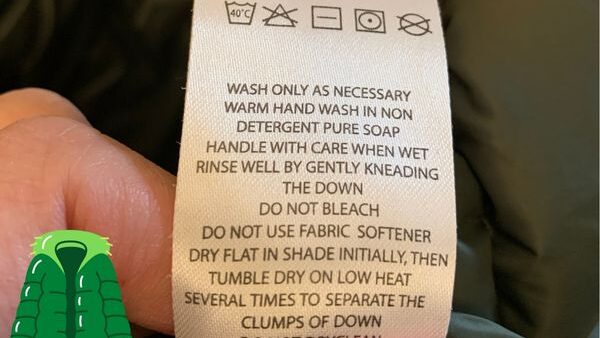
Key Takeaway: Rain jackets need to be properly maintained and replaced periodically in order to keep them functioning at optimal levels. For membrane based rain jackets, they should be replaced after two years of regular use while traditional styles last up to five years. Proper maintenance includes reading manufacturer instructions before washing, using approved cleaning agents, air drying instead of machine drying, avoiding storing it in a damp condition, reapplying DWR finish according to manufacturer guidelines, inspecting seams and zippers regularly for tears or breaks, storing the item in a cool dark place whenever possible and checking pockets are empty before putting away.
Care & Maintenance Tips For Rain Jackets
It’s important to keep your jacket clean and dry in order to maintain its water-resistance. Here are some tips on how you can properly care for your rain jacket:
Cleaning: Cleaning your rain jacket regularly will help extend its life. If the fabric of the jacket is made from nylon or polyester, then you can machine wash it using a mild detergent and cold water setting. For shell jackets such as GoreTex, washing with a technical cleaner designed specifically for waterproof garments is recommended in order to maintain breathability. Membrane based jackets should only be hand washed with a mild soap or detergent solution that does not contain any bleach or harsh chemicals.
Storage: Make sure that when storing your rain jacket, it’s completely dry before putting away in a cool place away from direct sunlight. This helps prevent mold growth which could damage the fabric of the garment over time. Also make sure there isn’t anything sharp inside the pockets which could tear through the material if left unchecked!
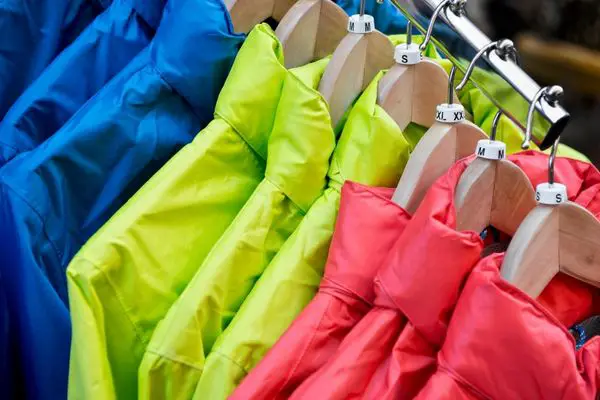
Waterproofing Spray/Wax/detergent: Using a waterproof spray, detergent or wax every few months will help ensure that your coat remains water resistant even after multiple washes and wearings over time. Be sure to read instructions carefully before applying these products as they may vary depending on what type of fabric your coat is made out of (e..g., nylon vs GoreTex).
I will not go into the details on how to do this in pratice as I wrote a comprehensive guide on waterproofing outdoor garments here.
Even with proper care and maintenance, all good things must come to an end eventually; this includes rain jackets too. Keep an eye out for signs such as cracking seams, worn down zippers, frayed cuffs/hems etc., which may indicate that it is time for you to replace yours soon enough.
By following these care and maintenance tips, you can ensure that your rain jacket will last for years to come. Next up, we’ll look at the best ways to store your rain jacket when it’s not in use.
Key Takeaway: A key takeaway from the above is that proper care and maintenance is essential for extending the life of your rain jacket. To keep your jacket in good condition, make sure to clean it regularly, store it away properly when not in use, and apply a waterproof spray or wax every few months. Additionally, look out for signs such as cracking seams or worn down zippers which may indicate that it’s time to replace your jacket soon.
FAQs
How long can you wear a waterproof jacket?
The length of time you can wear a jacket depends on the type of jacket and your environment. Generally, lightweight jackets made from breathable fabrics such as nylon or polyester are best for warm weather activities. These jackets will keep you cool and dry while providing protection from the sun’s rays. For colder climates, heavier insulated jackets with waterproof materials like Gore-Tex are recommended to keep you warm and dry in wet conditions. Additionally, layering multiple pieces of clothing is an effective way to adjust to changing temperatures throughout the day.
How often should you buy a new rain coat?
It depends on the type of coat and how often you use it. Generally, a good quality coat should last for several years if taken care of properly. If you are an avid hiker or outdoor enthusiast who spends a lot of time outdoors in harsh conditions, then it is recommended to buy a new coat every 2-3 years as the fabric may become worn down over time due to exposure to elements such as rain, wind, and sun. However, if you don’t spend much time outdoors or take proper care of your coat when not in use (e.g., storing it away from direct sunlight), then you may be able to get more than 3 years out of one before needing to replace it.
Do waterproof jackets lose their warmth?
Yes, jackets can lose their warmth over time. This is due to the breakdown of insulation materials and other components that make up a jacket’s construction. Regular wear and tear from outdoor activities such as hiking can also cause jackets to become less effective at retaining heat. To maintain a jacket’s warmth, it should be properly cared for by washing according to manufacturer instructions and storing in a cool, dry place when not in use. Additionally, replacing worn out or damaged parts may help extend the life of your jacket and keep you warm on future hikes.
How long can waterproof down jackets last?
Down jackets are a great choice for outdoor enthusiasts due to their warmth and lightweight design. Generally, down jackets can last up to 10 years or more if properly cared for. It is important to store the jacket in a cool, dry place when not in use and regularly clean it with a mild detergent. Additionally, using a waterproofing spray will help protect the jacket from moisture damage and extend its life even further. With proper care and maintenance, your down jacket should provide you with many years of reliable protection against cold weather conditions.
Conclusion
It is important to remember that the longevity of your rain jacket depends on a variety of factors, including the type of material it is made from and how well you care for it. With proper maintenance and regular cleaning, traditional rain jackets can last up to five years or more while membrane based jackets may need replacing after two years. When considering how long do jackets last, always keep in mind that no matter what type of jacket you have, if it starts to lose its water resistance then it’s time for a replacement.

